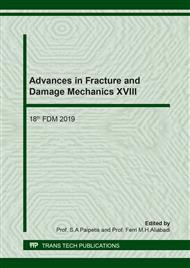p.234
p.240
p.246
p.252
p.258
p.263
p.269
p.275
p.282
Recovery of Fracture Toughness on Self-Healing Epoxies Using Ternary Nanomodified Microcapsules: A Parametric Study
Abstract:
This study is focused on the effect of the nanomodification of the microcapsules healing agent on the healing efficiency. In detail, nanomodified epoxy resin with both carbon nanotubes (CNTs) and carbon black (CB) diluted with a non-toxic solvent was encapsulated into UF capsules. The morphology of the external surface and the mean diameter was investigated via Scanning Electron Microscopy (SEM). In addition, the thermal stability was estimated with Thermogravimetric analysis and healing efficiency was evaluated for the polymer epoxy matrix. A parametric study was performed at various solvent percentages and catalyst percentages. Results indicated an increase of the healing efficiency with nanomodified capsules against of the use of conventional microcapsules.
Info:
Periodical:
Pages:
258-262
Citation:
Online since:
December 2019
Keywords:
Price:
Сopyright:
© 2020 Trans Tech Publications Ltd. All Rights Reserved
Share:
Citation:


